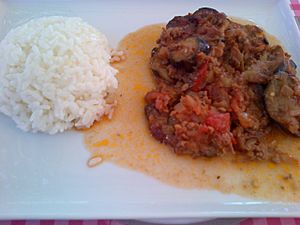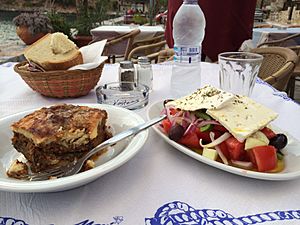Moussaka facts for kids

A dish of Egyptian Greek moussaka
|
|
| Course | Main course |
|---|---|
| Place of origin | Egypt, Greece, Middle East (cooked salad form), Levant |
| Region or state | The Balkans and Eastern Mediterranean |
| Serving temperature | Hot or cold |
| Main ingredients | Eggplant or potatoes, minced meat |
| Variations | Multiple |
Moussaka is a popular dish often made with eggplant or potatoes. It usually includes ground meat. This yummy meal is common in countries around the Balkans and the Middle East. There are many different ways to make it depending on where you are.
The most famous version in Europe and America is the Greek one. A Greek chef named Nikolaos Tselementes created it in the 1920s. Many moussaka recipes have a creamy top layer. This layer is often a milk-based sauce, like a béchamel sauce (a white sauce). In Greece, moussaka is made in layers and usually served hot. Tselementes even made a plant-based version for special fasting days. Romania also has a plant-based moussaka that uses mushrooms or a mix of onions and rice instead of meat.
Versions in Egypt, Turkey, and other Middle Eastern countries are quite different. In Egypt, messa'aa can be made without meat (plant-based) or with meat. The main ingredient is always fried eggplant. In Turkey, musakka has thin slices of fried eggplant served with a tomato and meat sauce. It can be eaten warm or at room temperature. In Saudi Arabia, muṣagga‘a is eaten hot. But in other Arab countries, it's often eaten cold, though sometimes hot too.
Contents
What's in a Name?
The English name "moussaka" comes from the Greek word mousakás. This word was borrowed from other Balkan languages. They all got it from Ottoman Turkish, which took it from the Arabic word muṣaqqa‘a. This Arabic word means "pounded" or "cold." The word "moussaka" first appeared in English in 1862.
How Moussaka is Made
Greek Moussaka
Most moussaka recipes use aubergine (eggplant) and tomato. They are often lightly fried. Usually, there's also minced meat, often lamb. The Greek way of making it involves layers of meat and eggplant. These layers are topped with a creamy béchamel sauce and then baked.
The modern Greek recipe was created by a Greek chef named Nikolaos Tselementes in the 1920s. He trained in France. His recipe has three layers, and each part is cooked separately before being put together for the final baking.
- The bottom layer has sliced eggplant that's lightly fried in olive oil.
- The middle layer is ground lamb cooked with chopped tomatoes, onion, garlic, and spices like cinnamon and black pepper.
- The top layer is a creamy béchamel sauce or a savory custard.
There are different ways to make this basic Greek recipe. Sometimes, there's no top sauce. Other times, different vegetables are added. These might include fried zucchini slices, partly fried potato slices, or fried mushrooms. Tselementes' cookbook also has a special version for fasting days. This version is plant-based and has no meat or dairy. It uses ground eggplant instead of meat, along with tomato sauce and bread crumbs.
Another Greek dish is (melitzanes) papoutsakia. This means "eggplant, little shoe style." It uses whole small eggplants stuffed with ground meat. They are topped with béchamel sauce and baked.
Moussaka in Other Southeast European Countries

In Albania, Bulgaria, the former Yugoslavia, and Romania, people often use potatoes instead of eggplant. They might use pork or beef mince. The top layer is usually milk or yogurt mixed with raw eggs. Sometimes a little flour is added.
There's also a three-layer version. The bottom layer has ground pork and beef. The middle layer has potato slices. The top layer is usually a creamy custard. Each layer is cooked on its own. Then they are put together in a pan and baked until the top is golden brown.
The Romanian version is often made with potatoes, eggplant, or cabbage. The layers start with the vegetable, then a layer of meat (usually pork), then more vegetables, until the pot is full. Sometimes bread crumbs are sprinkled on top. Other times, slices of tomatoes and crushed cheese are used. The dish is then filled with tomato sauce. There's also a version with pasta instead of vegetables. The "fasting" version, which is plant-based, uses mushrooms or a mix of cooked onions and rice instead of meat.
In the rest of the Balkans, the top layer is often a creamy custard. This is how the dish was introduced in the UK. Grated cheese or bread crumbs are often sprinkled on top.
Moussaka in the Levant
In the Levant, moussaka is a cooked dish mainly made from tomatoes and eggplant. It's similar to a Sicilian dish called caponata. It might also include chickpeas. This moussaka can be served cold as a mezze (a small appetizer dish) or served hot.
Egyptian Moussaka
The Egyptian way of making moussaka uses layers of fried eggplant. These are soaked in tomato sauce and then baked. A layer of seasoned cooked ground beef is usually added between the eggplant layers before baking. This dish can be served hot. But it's often chilled for a day or so to make the taste even better.
Turkish Moussaka

Turkish musakka is not made in layers. Instead, thin slices of eggplant are fried. They are served with a tomato-based meat sauce. This sauce is seasoned with green peppers, garlic, and onions. It's usually eaten with pilav (a rice dish) and cacık (a yogurt dip). There are also versions with zucchini (kabak musakka), carrots (havuç musakka), and potatoes (patates musakka).
See also
 In Spanish: Musaca para niños
In Spanish: Musaca para niños


